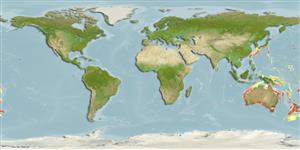Elasmobranchi (squali e razze) (sharks and rays) >
Torpediniformes (Electric rays) >
Torpedinidae (Electric rays)
Eponymy: Francis Alexander ‘Frank’ McNeill (1896–1969) was an Australian ichthyologist and carcinologist at the Australian Museum in Sydney. [...] (Ref. 128868), visit book page.
More on author: Whitley.
Environment: milieu / climate zone / depth range / distribution range
Ecologia
marino batidemersale; distribuzione batimetrica 90 - 750 m (Ref. 9917). Deep-water
Eastern Indian Ocean: southern Australia, from Port Headland to Tasmania and off the Swain Reefs in Queensland. Torpedo macneilli is similar and probably synonymous with Torpedo fairchildi from New Zealand (Ref. 12951).
Length at first maturity / Size / Peso / Age
Maturity: Lm ?, range 60 - ? cm
Max length : 107 cm TL maschio/sesso non determinato; (Ref. 9917)
An offshore species found on continental shelves and slopes (Ref. 9917, 75154). Found near rocky reefs, over sand and mud bottoms (Ref. 12951). Feeds on fishes and crustaceans (Ref. 12951). Ovoviviparous (Ref. 50449). Capable of severely shocking people if handled (Ref. 9917).
Life cycle and mating behavior
Maturità | Riproduzione | Deposizione | Uova | Fecundity | Larve
Exhibit ovoviparity (aplacental viviparity), with embryos feeding initially on yolk, then receiving additional nourishment from the mother by indirect absorption of uterine fluid enriched with mucus, fat or protein through specialised structures (Ref. 50449).
Compagno, L.J.V. and P.R. Last, 1999. Torpedinidae. Torpedos. p. 1449-1451. In K.E. Carpenter and V.H. Niem (eds.) FAO identification guide for fishery purposes. The living marine resources of the Western Central Pacific. FAO, Rome. (Ref. 9917)
IUCN Red List Status (Ref. 130435: Version 2024-1)
Human uses
Pesca: di nessun interesse
Strumenti
Special reports
Download XML
Fonti Internet
Estimates based on models
Preferred temperature (Ref.
123201): 10.4 - 20.6, mean 14.1 °C (based on 128 cells).
Phylogenetic diversity index (Ref.
82804): PD
50 = 0.5001 [Uniqueness, from 0.5 = low to 2.0 = high].
Bayesian length-weight: a=0.01479 (0.00665 - 0.03288), b=2.96 (2.77 - 3.15), in cm total length, based on LWR estimates for this (Sub)family-body shape (Ref.
93245).
Trophic level (Ref.
69278): 4.0 ±0.65 se; based on food items.
Resilienza (Ref.
120179): Molto basso, tempo minimo di raddoppiamento della popolazione più di 14 anni (Preliminary K or Fecundity.).
Fishing Vulnerability (Ref.
59153): High vulnerability (64 of 100).
